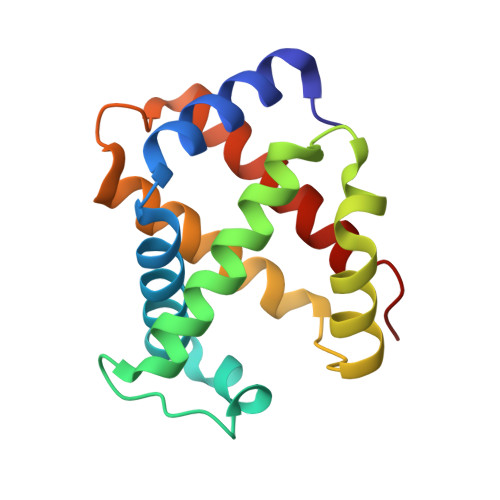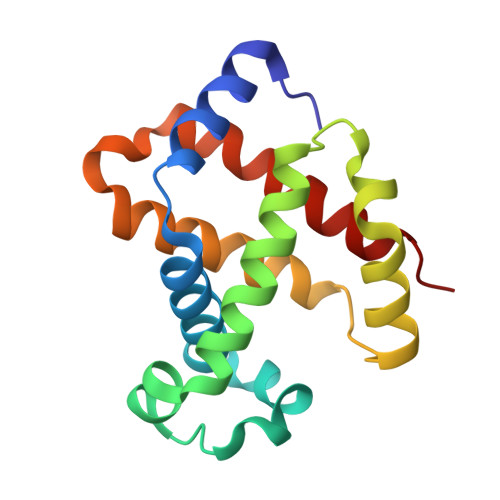Crystallographic evidence for a new ensemble of ligand-induced allosteric transitions in hemoglobin: the T-to-T(high) quaternary transitions.
Kavanaugh, J.S., Rogers, P.H., Arnone, A.(2005) Biochemistry 44: 6101-6121
- PubMed: 15835899
- DOI: https://doi.org/10.1021/bi047813a
- Primary Citation of Related Structures:
1XXT, 1XY0, 1XZ5, 1XZ7, 1XZU, 1XZV, 1Y09, 1Y0A, 1Y0C, 1Y0D, 1Y0T, 1Y0W, 1Y22, 1Y2Z, 1Y31, 1Y35, 1Y45, 1Y46, 1Y4B, 1Y4F, 1Y4G, 1Y4P, 1Y4Q, 1Y4R, 1Y4V, 1Y5F, 1Y5J, 1Y5K, 1Y7C, 1Y7D, 1Y7G, 1Y7Z, 1Y83, 1Y85, 1Y8W, 1YDZ, 1YE0, 1YE1, 1YE2, 1YEN, 1YEO, 1YEQ, 1YEU, 1YEV, 1YG5, 1YGD, 1YGF, 1YH9, 1YHE, 1YHR - PubMed Abstract:
A detailed description of hemoglobin cooperativity requires knowledge of the dimer-dimer interactions responsible for the low ligand affinity of the quaternary-T tetramer, the "quaternary-T constraints", along with stereochemical pathways that specify how ligand binding disrupts these quaternary constraints. The recent mutagenic screen of Noble et al. [Noble, R. W., et al. (2001) Biochemistry 40, 12357-12368] has identified the major region of quaternary constraint to be a cluster of residues at the alpha1beta2 interface that is centered at Trp37beta. In this paper, crystallographic studies are presented for most of the mutant hemoglobins studied by Noble et al. These crystallographic experiments identify structural transitions-referred to as T-to-T(High) transitions-between the quaternary-T structure of wild-type deoxyhemoglobin and an ensemble of related T-like quaternary structures that are induced by some mutations in the Trp37beta cluster and/or by exposing crystals of wild-type or mutant deoxyhemoglobins to oxygen. The T-to-T(High) quaternary transitions consist of a rotation of the alpha1beta1 dimer relative to the alpha2beta2 dimer as well as a coupled alphabeta dimer bending component that consists of a small rotation of the alpha1 subunit relative to the beta1 subunit (and a symmetry related rotation of the alpha2 subunit relative to the beta2 subunit). In addition, differences in subunit tertiary structure associated with the T-to-T(High) transitions suggest two stereochemical pathways (one associated with the alpha subunits and one associated with the betasubunits) by which ligand binding specifically disrupts quaternary constraints in the Trp37beta cluster. In the alpha subunits, ligand binding induces a shift of the heme iron producing tension in a chain of covalent bonds that extends from the Fe-N(epsilon)(2)His(F8)alpha1 bond to the peptide backbone bonds of residues His87(F8)alpha1 and Ala88(F9)alpha1. This tension induces an alpha-to-pi transition in the COOH-terminal end of the F-helix that shifts the beta-carbon of Ala88alpha1 by approximately 1.5 A directly into the side chain of Tyr140alpha1 (a key residue in the Trp37beta2 cluster). Collectively these structural changes constitute a relatively short pathway by which ligand binding forces Tyr140alpha1 into the alpha1beta2 interface disrupting quaternary constraints associated with the Trp37beta2 cluster. In the beta subunits, our analysis suggests a more extended energy transduction pathway in which ligand-induced beta1-heme movement triggers tertiary changes in the beta1 subunit that promote alpha1beta1 dimer bending that disrupts quaternary constraints in the Trp37beta2 cluster at the alpha1beta2 interface.
- Department of Biochemistry, Roy J. and Lucille A. Carver College of Medicine, The University of Iowa, Iowa City, Iowa 52242, USA.
Organizational Affiliation:



















